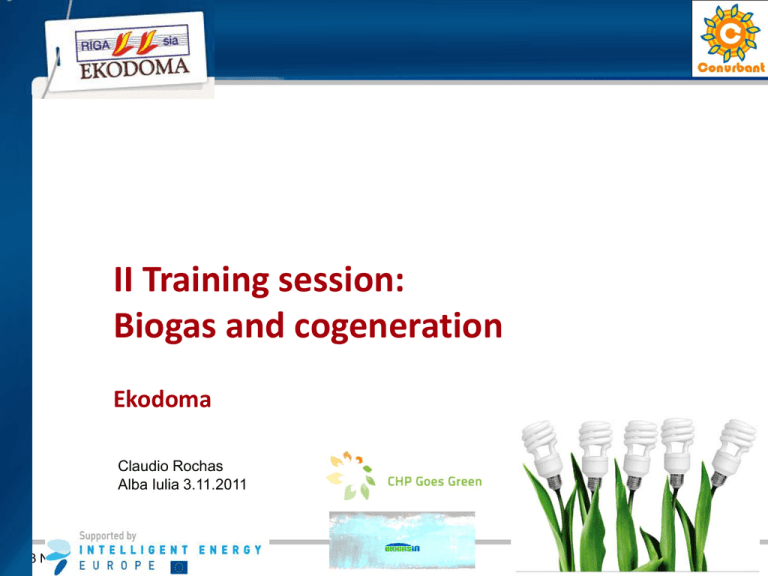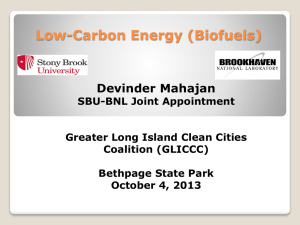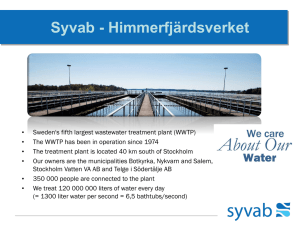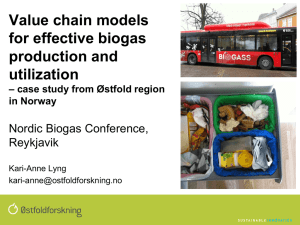II Training session: Biogas and cogeneration Ekodoma
advertisement

II Training session: Biogas and cogeneration Ekodoma Claudio Rochas Alba Iulia 3.11.2011 3 November 2011 Ekodoma 1 Introduction 15 November 1991 Two professors of Riga Technical University 15 November 2011 3 November 2011 20 years 18 employees 3 divisions Ekodoma 2 Content Definitions and technologies CHP versus separate generation of heat and power Do you need a CHP unit? Examples: District heating system Biogas production and use Economical assessment of CHP projects. Simple example 3 November 2011 Ekodoma 3 Cogeneration - definitions Cogeneration is the simultaneous generation in one process of thermal energy and electrical and/or mechanical energy; useful heat is heat produced in a cogeneration process to satisfy an economically justifiable demand for heat or cooling; economically justifiable demand is a demand that does not exceed the needs for heat or cooling and which would otherwise be satisfied at market conditions by energy generation processes other than cogeneration. DIRECTIVE 2004/8/EC 3 November 2011 Ekodoma 4 Cogeneration technologies Combined cycle gas turbine with heat recovery Steam backpressure turbine Steam condensing extraction turbine Gas turbine with heat recovery Internal combustion engine Microturbines Stirling engines Steam engines Fuel cells ORC 3 November 2011 Ekodoma 5 Cogeneration - definitions Cogeneration units: Micro-cogeneration means below 50 kWe; Small-scale cogeneration means below 1 MWe. Power to heat ratio ( ): the ratio between electricity from cogeneration and useful heat when operating in full cogeneration mode 3 November 2011 Ekodoma 6 Default power to heat ratio Type of unit value Combined cycle gas turbine with heat recovery 0.95 Steam backpressure turbine 0.45 Steam condensing extraction turbine 0.45 Gas turbine with heat recovery 0.55 Internal combustion engine 0.75 3 November 2011 Ekodoma 7 CHP and separate generation Losses - 5 Fuel input 100 Useful heat - 95 Losses - 57 Fuel input 100 Electricity - 43 Losses - 15 Fuel input 100 Electricity - 35 Useful heat - 50 3 November 2011 Ekodoma 8 Efficiency coefficient for heat generation only Fuel type Solid fuels 3 November 2011 Hard coal/coke Peat Wood fuels Oil, LPG Biofuels Natural gas Biogas Overall efficiency 0.88 0.86 0.86 0.89 0.89 0.9 0.7 Ekodoma 9 Efficiency coefficient for electricity generation only Fuel type Solid fuels 3 November 2011 Hard coal/coke Peat Wood fuels Oil, LPG Biofuels Natural gas Biogas Overall efficiency 0.442 0.390 0.330 0.442 0.442 0.525 0.420 Ekodoma 10 Alternatives for heat and electricity supply Condensing power plant Electricity CHP Electricity Heat energy Heat energy Boiler house 3 November 2011 Ekodoma 11 CHP and separate generation Fuel input Separate generation Power station 43% 81 53 Boiler house 95% Total 134 3 November 2011 Fuel input Output CHP Electricity 35 Heat 50 Electricity 35% Useful heat 50% 100 134 100 Total 100 Primary energy savings 25% 134 Ekodoma 12 District heating - example Jelgava municipality: New biomass fired cogeneration station 23 MWe 44 MWt 3 November 2011 Ekodoma 13 Current situation - 2010 Fortum Jelgava Heat energy generation 240GWh Heat energy sales 200GWh Heat energy losses 16.8% District heating network 70.4 km Electricity generation 3 November 2011 32GWh Ekodoma 14 Energy sources in Jelgava Kalciema 2.5MW Ganibu I 113MW Instituta 0.9MW Skautu 0.3MW Aviacijas 28MW Ganibu II 5MWt/4MWel Filozofu 0.8MW New link Neretas 1MW New CHP 44MWt/23MWel 3 November 2011 Ekodoma 15 Heat load profile Load, MW Heat only boilers Natural gas 2.5MW CHP Gas fired Time, days 3 November 2011 Ekodoma 16 Heat curve Load, MW Heat only boilers Natural gas 2.5MW CHP Gas fired Time, days 3 November 2011 Ekodoma 17 Heat load profile – with Biomass CHP Heat only boilers Natural gas Load, MW 2.5MW CHP Biomass 2.5MW CHP Gas fired Time, days 3 November 2011 Ekodoma 18 Heat load curve Load, MW Heat only boilers Natural gas 2.5MW CHP Biomass 2.5MW CHP Gas fired Time, days 3 November 2011 Ekodoma 19 Investment Boiler block and turbine €32.1m Engineering comm €8.9m Automatisation €1.5m Electrical installation €3.4m Civil engineering works and frames €8.1m Other €13.3m Total €67.4m Cofinancing from ES - €6.0m 3 November 2011 Ekodoma 20 Time schedule Beginning of project 01.06.2011 Civil engineering works 01.10.2011 Plant erection (boiler block and turbine) 25.06.2012 Mounting 01.12.2012 Boiler testing with natural gas 12.04.2013 Boiler testing with biomass 18.05.2013 Synchronization 05.06.2013 CHP under testing regime 18.07.2013 CHP operation 09.09.2013 3 November 2011 Ekodoma 21 Environmental benefits CO2 emission from heat energy generation, CO2/kWh 250 200 150 100 50 0 2005 2006 2007 2008 2009 2010 2011 2013 2015 2018 2020 CO2 emissions reduced by 75%-90% (44-54 thous. T /year) Overall efficiency in CHP mode – 89% 3 November 2011 Ekodoma 22 Definition of biogas Biogas typically refers to a gas produced by the biological breakdown of organic matter in the absence of oxygen. Biogas is a mixture of gases produced by the fermentation of waste by microorganisms under anaerobic conditions. The gases present in the mixture are methane (CH4), carbon dioxide (CO2) and traces of odorigenic sulphates. The methane contained in the biogas may be used as fuel. 3 November 2011 Ekodoma 23 Composition of biogas Component Methane, CH4 Carbon dioxide, CO2 Water vapour, H2O Carbon oxide, CO Nitrogen, N2 Hydrogen, H2 Hydrogen sulphide, H2S Oxigen, O2 3 November 2011 Fate clic per % modificare il 50-75 formato 25-45 del testo della struttura 1-2 0-0.3livello Secondo 1-5 struttura 0-3 Terzo livello 0.1-0.5 struttura <2 Quarto Ekodoma livello 24 Biogas in terms of livestock units 670 = 250 = 7 = 3 = 1 1 lu = 500 kg lu = livestock unit 1 lu = 1,3 m3 biogas/day 3 November 2011 Ekodoma 25 Biogas in terms of energy crops Energy crops (e.g., maize silage) 1 ha: = 60 t (fresh matter) = 22 t (dry matter) = 9 900 m3 biogas 3 November 2011 Ekodoma 26 Formation of biogas Biomass Dry matter Water Organic Lignin Fats Inorganic Sugars Proteins Minerals Methane and Carbon dioxide Biogas (CH4 and CO2) 3 November 2011 Ekodoma 27 Feedstock for biogas production As a feedstock for anaerobic digestion can be used several kind of organic matter, e.g.: Manure Food waste and waste from food processing industry Cropping, forest and wood processing waste Peat Organic fraction of municipal waste Sewage sludge Greens from plants ... 3 November 2011 Ekodoma 28 Biogas feedstock Manure Food waste Agricultural waste 3 November 2011 Ekodoma 29 Gas yield from different substrates Biogas yield (outcome) depends from: Feedstock used for anaerobic fermentation (substrate), Conditions during the anaerobic digestion process (temperature, pH, retention time), Content of micro-organisms, Other factors like components and composition of organic matter. 3 November 2011 Ekodoma 30 Gas yields from different substrates Biogas yields (rel. to fresh DM oDM m3 Biogas substance and cult. area) (in %) (% of DM) 40-75 45-70 40 83 Grain straw (diverse) 85-90 85-89 Poultry manure 50-70 60-70 Vegetable waste 5-20 60-90 Canteen waste 9-18 90-95 Chicken manure 21 75 12-15 90 Grass 20 80 Maize silage (dow stage) 30 95 Maize silage (wax ripeness stage) 33 96 Horse manure 28 75 Rape cake 91 93 12-25 65-85 Bio waste Grass silage Potato waste Cattle manure Wheat grain 90 Sugar beets leaf silage 18 3 November 2011 81 per kg oDM Fate clic per m3/t FM m3/ha 0,45 120il -modificare 0,455 220 5720 0,3-0,6 217-481testo1084-2403 formato del 0,55-0,65 300-490 -della 0,45 struttura 80 -0,55-0,78 80-170 -- 160 -Secondo livello 0,25-0,35 27-47 -0,48 160 4480 struttura 0,6 151 5600 0,5 0,63 196 7385 Terzo82 livello -0,72 612 1224 struttura 0,2-0,3 650 3250 Quarto 90 3590 Ekodoma livello 0,45 Source: GERBIO 31 Main components of the farmscale biogas plant Source: BiG>East Biogas Handbook 3 November 2011 Ekodoma 32 Main components of the farmscale biogas plant Loading of solid and liquid feedstock 3 November 2011 Ekodoma 33 Main components of the farmscale biogas plant Bioreactor Digestate storage tanks 3 November 2011 Gas holder CHP unit Ekodoma 34 Biogas has many utilisations Source: FITEC 3 November 2011 Ekodoma 35 Efficient biogas pathways (bold arrows) R a w b io g a s H ig h te c h te c h n o lo g y F u e lfo r c a r s In je c tio n in to th e g r id E le c tr ic itya n d h ig h h e a tu s e H e a to n ly E e le c tr ic itya n d littleh e a tu s e U p g r a d e d b io g a sb io m e th a n e Source: AEBIOM 3 November 2011 Ekodoma 36 CHP unit Standard utilisation for biogas Most common is in internal combustion engines Efficiency up to 90% Power to heat ratio up to 70% Typically: 35% Electricity 65% Heat Alternatives: Stirling-Motors, micro gas turbines and fuel cells 3 November 2011 Ekodoma 37 Cost for biogas plant 3000- 4000 €/kWe for average size biogas plant (250-500 kWe) Cheap and low standard plant is 2800 €/kWe Medium standard plant is 3500 €/kWe High standard plant is 4000 €/kWe Waste treatment plants (more complex feedstock preparation and treatment process) are about 5600 €/kWe. 3 November 2011 Ekodoma 38 Maintaining the CHP plant 0.3 – 2.5 €c/kWhel. Maintenance costs for all other components of a biogas plant are about 1 – 3% of the total investment sum (Steiner, 2009). In Germany, the transport of each m3 of biomass costs about 2 – 2.9 € per kilometer (Theissing, 2006). 3 November 2011 Ekodoma 39 Planning: CHP plant Costs for planning the biogas plant generally at be estimated 10% of the total investment. Costs for the CHP about 20% of the total investment (Steiner, 2009). Fermenter: Costs for the fermenter can reach 40 – 50% of the total investment sum (Steiner, 2009) 3 November 2011 Ekodoma 40 Biogas upgrading Biogas can be used for the same purposes as natural gas Upgrading to biomethane Methane content > 95% Common methods use the absorbtion with solvent. Water solvent scrubbing, organic solvent scrubbing, pressure swing absorption Costs are not linear to the plant size Biogas input > 500 m³/h 3 November 2011 Ekodoma 41 Biogas as vehicle fuel Utilisation of biomethane in the transport sector is a technology with great potential Biomethane is used in the same way like natural gas There are specially built biogas vehicles Biomethane has the highest potential as vehicle fuel of all biofuels 3 November 2011 Ekodoma 42 Biomethane for grid injection Upgraded biogas (biomethane) can be injected and distributed through the natural gas grid Connect rural production areas with high populatet areas The gas can be used on a higher efficiency level The Biomethane has to fit the national standards for natural gas The costs are the same as for upgrading plus the grid connection 3 November 2011 Source: FITEC Ekodoma 43 Biogas and greenhouse gas emissions The combustion of biogas releases CO2. However, the main difference, when compared to fossil fuels, is that the carbon in biogas was recently up taken from the atmosphere, by photosynthetic activity of the plants. The carbon cycle of biogas is thus closed within a very short time (between one and several years). Biogas production by anaerobic digestion reduces also emissions of methane (CH4) and nitrous oxide (N2O) from storage and utilization of untreated animal manure as fertilizer. 3 November 2011 Ekodoma 44 Biogas production – a tool for manure management Positive changes of liquid manure properties through fermentation: Decomposition of organic substance • • Decomposition rates oDM: of up to 40% The fermented liquid manure can be pumped and sprayed better compared to the raw liquid manure Odor reduction Reduction of the odor causing substances (humid acids, Phenols, Phenol derivate) 3 November 2011 Ekodoma 45 Use of biogas digestate Digestate can be spread on the fields - no hygiene restrictions with animal slurry and plant material Improved Fertilizer avoids nutrient losses reduces burning effect on plants improves flowing properties improves plant compatibility improves plant health reduces germination ability of weed seeds Environmentally sound reduces the intensity of odor reduces air pollution through methane and ammonia reduces the wash out of nitrate sanitizes liquid manure recycles organic residues (co-fermentation) 3 November 2011 Ekodoma 46 Economical assessment Example: CHP Unit- internal combustion engine – natural gas Electrical nominal capacity, EJ = EJ/Qs 4,0 MWe 0,75 (power to heat ration) Heat nominal capacity, Qs = EJ/ 5,33 MWt Overall efficiency, 0,90 Operational hours 4000 Hours/year =(E+Q)/F Generated electricity, E 16000 MWhe/year Generated heat energy, Q 21333 MWht/year Fuel consumption F=(E+Q)/ 41481 MWhf/year Fuel lower calorific value, Qzd 9,3 MWh/t.nm3 Fuel consumption, F = F/Qz 4460 t.nm3/year Fuel tariff, Tg 325,5 €/t.nm3 Unit fuel costs, CF=Tg/Qz Fuel (variable) cost, VC=CF x F 3 November 2011 35 €/MWhf 1 451 835 € Ekodoma 47 Investment costs Specific investment costs, IP Total investment costs, K=IP x EJ x 1000 Discount rate, r Economical life time, n 940 €/kWe 3 760 000 € 10% 10 years Note: Operation and maintenance costs are not included 40 € /kWe x 4000kWe = 160 000 €/year 3 November 2011 Ekodoma 48 Project cash flow analysis 6000 5000 4000 3000 k Euro 2000 1000 0 -1000 1 2 3 4 5 6 7 8 9 10 -2000 -3000 -4000 -5000 3 November 2011 Ekodoma 49 References CHP Goes Green BiogasIN http://www.chp-goes-green.info/ http://www.biogasin.org/ Urbanbiogas Big-East COGEN DIRECTIVE 2004/8/EC 3 November 2011 Ekodoma 50 Thank you! Ekodoma 3-3 Noliktavas Street, Riga LV1010, Latvia Tel: +371 7323212 Fax: +371 7323210 Mob: +371 26745700 email: claudio@ekodoma.lv Web side Ekodoma: www.ekodoma.lv 3 November 2011 Ekodoma 51







